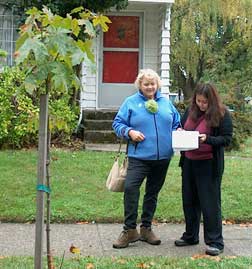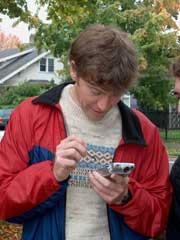|
Main Project Summary Two key events in the Spring, 2004 led to this project. First,
Drix, the Chairman of the West University Neighborhood (WUN) contacted the
University of Oregon to seek assistance in visualizing his neighborhood in
some way. Drix's request eventually trickled to Marc Schlossberg, an
Assistant Professor in the Department of Planning, Public Policy and
Management (PPPM). Professor Schlossberg annually teaches a GIS
class focusing on social applications and was interested in having his
class to work for a local neighborhood. The 2nd key event in the Spring was the awarding of a small classroom technology grant to Professor Schlossberg by the Northwest Academic Computing Consortium (NWACC). This grant was intended to bring new technologies into the classroom, and Professor Schlossberg intended to create new teaching tools around mobile GIS technology with handheld computers.. The timing was such that Professor Schlossberg thought it would be a good idea to match Drix's request with the NWACC grant, and presented the idea of a community-mapping project to the neighborhood association in May, 2004. Three key points were made by Professor Schlossberg during this presentation to the WUN. First, the project was intended to place control over the basic structure and content of the project in the hands of neighborhood residents. The effort, if it were to happen, would be based on the neighborhood inviting the class and its students in, and not the other way around - this was not to be a class project conducted on a neighborhood without the neighborhood's consent. Second, as a class-based exercise, the educational value to students of the project was essential. And third, the project should be viewed as an opportunity to establish positive university-community interactions where stereotypes and mistrust between the two groups could be broken down and that each could derive benefit from the overall project.
Through this meeting process and through discussions at regular WUN monthly meetings, the neighborhood decided they wanted to know about three key assets in their neighborhood:
(to be continued...) |

 After a month of deliberation, the neighborhood decided to invite the
class in to the neighborhood and to jointly develop a plan of action. Over
the summer, 2004, Professor Schlossberg, his teaching assistant Darren
Wyss, and two members of the WUN board (Drix and Deborah Healey) met on
multiple occasions to try to determine what the mapping project should
entail. There were three guiding limits: 1) the project should be of
immediate value to the neighborhood; 2) the project should be small enough
in scope to ensure some success at the end; and 3) students must be able
to gain tangible skills.
After a month of deliberation, the neighborhood decided to invite the
class in to the neighborhood and to jointly develop a plan of action. Over
the summer, 2004, Professor Schlossberg, his teaching assistant Darren
Wyss, and two members of the WUN board (Drix and Deborah Healey) met on
multiple occasions to try to determine what the mapping project should
entail. There were three guiding limits: 1) the project should be of
immediate value to the neighborhood; 2) the project should be small enough
in scope to ensure some success at the end; and 3) students must be able
to gain tangible skills.